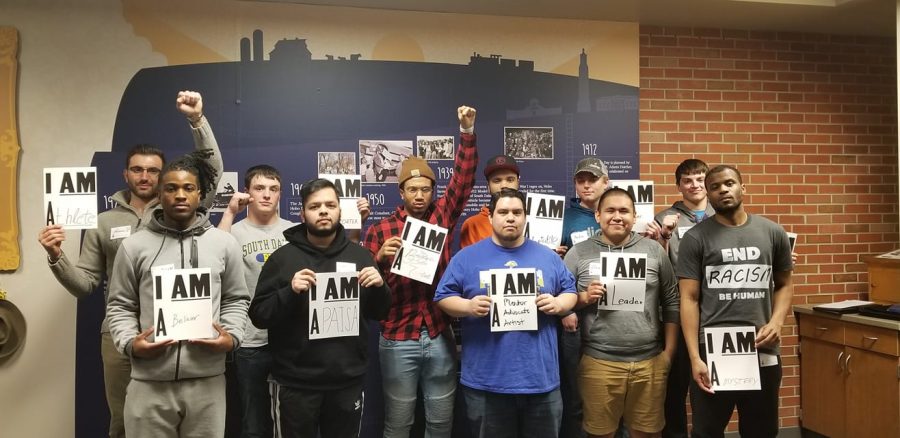Faculty groups create “Moment of Brotherhood” for men of color
Dr. Florencio Urias Aranda III
Men who attended the moment of brotherhood pose with signs that describe who they are, like a leader or artist.
March 29, 2019
Los Hombres Latinos and the Brothers’ Circle hosted their first-ever “Moment of Brotherhood” meeting to connect young men of color to friends, allies and mentors in the Campanile Room Thursday.
The event aimed to help men of color overcome incidents of discrimination through brotherhood and recognizing that they are more than what society perceives them as. The event began by discussing discrimination against men of color, especially an incident where two Native American men were taking a college tour at Colorado State University and had the cops called on them.
The hosts and attendees did not see this as an isolated incident, and several students discussed their experiences of feeling like an outsider on campus.
“Don’t allow yourself to be labeled. Choose your own label,” said Florencio Aranda III, the Latina/o/x program adviser. “As a man of color or an ally, continue to advocate and recognize that you are special.”
A problem Russ Chávez, the director for Veterans Affairs, noticed is that the population of South Dakota is not reflected accurately in the university, particularly for Native Americans.
“I get looked at every day,” said Shedrick Flournoy, a sophomore interdisciplinary studies major. “So it makes me feel more comfortable to be around people who respect diversity.”
The hosts also raised awareness of the significance of the statement “I am a man” for men of color. “Boy” was commonly used by white people to refer to men of color to degrade them, so men of color began using the phrase in their activism, according to Aranda.
The event’s hosts had attendees find words that defined them outside of what was immediately obvious to the people around them and also asked them to write down five things the sponsoring groups could help them with.
“I feel like people of our generation are told not to ask [for things they need], but we should realize it’s okay to ask when you need it,” said Carl Weathers IV, a junior graphic design major.
Weathers came to the event to find allies and friends and feels that the event fulfilled his expectations.
“Making more people aware of things like this is important because this had a small number of people, but it could help so many people that aren’t people of color,” Weathers said. “I was able to make a lot of
connections my faculty and contemporaries. Not only do I have a foundation and sense of brotherhood, but I think it helps eliminate ignorance and encourage discussion.”
Aranda hopes to see the “Moment of Brotherhood” meetings continue in the future. In the spring 2018 semester, he and Chávez began reaching out to other men of color on campus to start the Los Hombres Latinos group.
“I just felt a need to set up an organization that would serve as a support group for me s a person of color and new employee,” Aranda said.
Both Los Hombres Latinos and The Brother’s Circle work to provide support, mentorship and programming for male students, staff and faculty of color. While Los Hombres Latinos focuses primarily on Latino men and The Brother’s Circle on African American and African men, both groups welcome faculty and staff of all genders, ethnicities and races to participate if they want to actively support men of color.
“The reason why we have this space is because you are men of color, but you are also more than that,” Aranda said. “Don’t let other people’s perceptions stop you.”
























